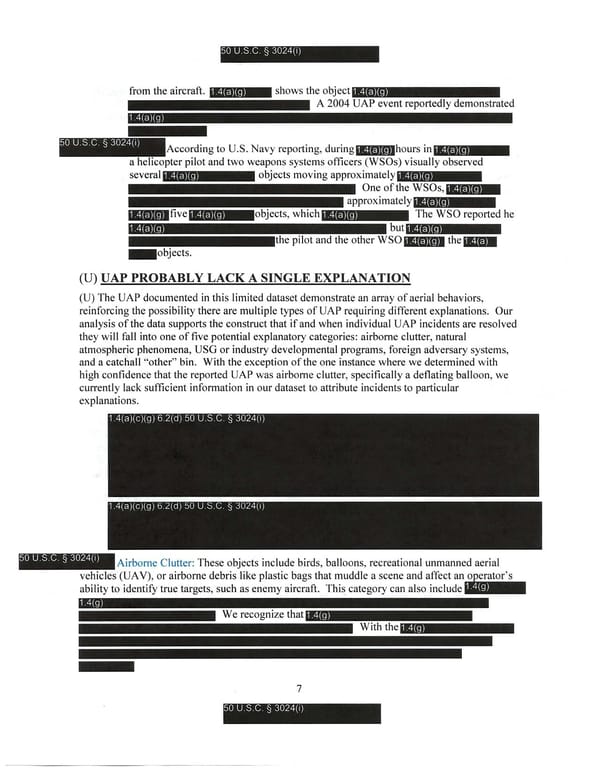50 U.S.C. § 3024(i) from the aircraft. Dlll m • rIl!EJllll(!JI'!'II.'-- shows the object 1.4(a)(g) A 2004 UAP event reportedly demonstrated 1.4(a)(g) 50 U.S.C. § 3024(i) According to U .S. Navy reporting , duringlClEJlC!)lhours in 1.4(a)(g) a helicopter pilot and two weapons systems officers (WSOs) visually observed several objects moving approximately 1.4(a)(g) ,;;;;.;;;;;;;~;;;~ One of the WSOs,1IIEJm) ! approximately IIIE1ImIIfive objects , wh ich The WSO reported he 1.4(a)(g) 1.4(a)(g) but ••••••••••• the pilot and the other WSO IIlEJIfiIJI the IIlEJII _objects. (U) UAP PROBABLY LACK A SINGLE EXPLANATION (U) The UAP documented in this limited dataset demonstrate an array of aerial behaviors, reinforcing the possibility there are multiple types of UAP requiring different explanations . Our analysis of the data supports the construct that if and when individual UAP incidents are resolved they will fall into one of five potential explanatory categories: airborne clutter , natural atmospheric phenomena , usa or industry developmental programs , foreign adversary systems , and a catchall "other" bin. With the exception of the one instance where we determined with high confidence that the reported UAP was airborne clutter , specifically a deflating balloon , we currently lack sufficient information in our dataset to attribute incidents to particular explanations . 1.4(a)(c)(g) 6.2(d) 50 u.s.c. § 3024(1) I 50 U.S .C. § 3024(i) Airborne Clutter: These objects include birds , balloons, recreational unmanned aerial vehicles (UA V) , or airborne debris like plastic bags that muddle a scene and affect an __ ability to identify true targets, such as enemy aircraft. This category can also include " 1.4(g) We recognize that 1.4(g) With the 1.4(g) 7 50 U.S.C . § 3024(i)
 Unidentified Aerial Phenomena | NI Report Page 13 Page 15
Unidentified Aerial Phenomena | NI Report Page 13 Page 15